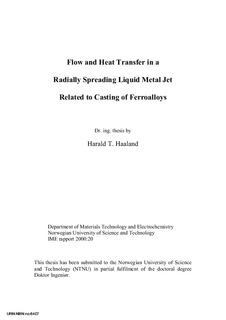| dc.contributor.author | Haaland, Harald | nb_NO |
| dc.date.accessioned | 2014-12-19T13:25:08Z | |
| dc.date.available | 2014-12-19T13:25:08Z | |
| dc.date.created | 2008-12-02 | nb_NO |
| dc.date.issued | 2000 | nb_NO |
| dc.identifier | 125422 | nb_NO |
| dc.identifier.isbn | 82-7984-109-1 | nb_NO |
| dc.identifier.uri | http://hdl.handle.net/11250/248744 | |
| dc.description.abstract | In the past more and more advanced and fine-tuned processes for steel production have resulted in increased demands for new and more costeffective ferroalloys used as constituents in the processes. Casting techniques and equipment are continually studied for potential improvements. In order to ensure a high and consistent quality in the alloys and the casting equipment, the heat transfer from the alloy to the mould during casting must be understood. Research on free metal flows is scarce and to remedy this a doctoral study at the Norwegian University of Science and Technology was initiated.
The study was limited to the region around the impingement point of the metal jet, because this is the critical area for both heat and mass transfer. The flow develops radially, first as a thin film spreading evenly over the surface. At a certain point the thickness of the film increases suddenly - known as a hydraulic jump. Only steady-state conditions on a flat plate (without accumulation of fluid) are studied. The jump develops before the flow reaches the edge of the plate and maintains this position until steady-state conditions are obtained. This system is believed to be a good approximation for the initial conditions during the filling of an open mould. This is also the period when the thermal load on the mould is greatest.
Numerous practical and mathematical simulations have been carried out and a relatively simple analytical model depicting the surface rofile of the liquid metal including heat transfer to the surroundings has been developed. The computational fluid dynamics code FLUENT was also used to compute the surface profile with the Volume-Of-Fluid technique, but with little success. The code was instead used to determine the flow and temperature fields inside the already established surface profile.Various laminar and turbulent flow models (variations of the k - εmodel) were tried and compared. Experiments with water were carried out for studying the flow field. Tin was used for heat transfer studies. Finally, these simulations were compared with results from the practical experiments.
Introductory experiments were carried out with ferrosilicon with the intent to perform complete experiments with this metal.Measured heat flow usually exceeded predicted values, particularly in the stagnation region. Good agreement is shown between the results from the FLUENT simulations and the new analytic model, which shows good promise of acting as a useful alternative to the much more demanding numerical simulations. | nb_NO |
| dc.language | eng | nb_NO |
| dc.publisher | Norges teknisk-naturvitenskapelige universitet, Fakultet for naturvitenskap og teknologi | nb_NO |
| dc.relation.ispartofseries | Dr. ingeniøravhandling, 0809-103X; 2000:83 | nb_NO |
| dc.subject | Materials science | en_GB |
| dc.subject | TECHNOLOGY: Materials science | en_GB |
| dc.title | Flow and Heat Transfer in a Radially Spreading Liquid Metal Jet Related to Casting of Ferroalloys | nb_NO |
| dc.type | Doctoral thesis | nb_NO |
| dc.source.pagenumber | 262 | nb_NO |
| dc.contributor.department | Norges teknisk-naturvitenskapelige universitet, Fakultet for naturvitenskap og teknologi | nb_NO |
| dc.contributor.department | Norges teknisk-naturvitenskapelige universitet, Fakultet for naturvitenskap og teknologi | nb_NO |
| dc.contributor.department | Norges teknisk-naturvitenskapelige universitet, Fakultet for naturvitenskap og teknologi, Institutt for materialteknologi | nb_NO |
| dc.description.degree | dr.ing. | nb_NO |
| dc.description.degree | dr.ing. | en_GB |
